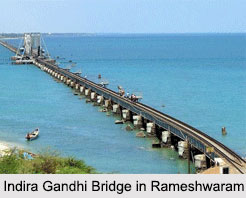 Rameshwaram Beach in Tamil Nadu is a serene beach with shallow waters. This beach is an ideal spot for tourists which also offer certain water sports. It is surrounded by Palk Strait and the Gulf of Mannar and it is a popular pilgrimage destination for both Saivaites and Vaishnavaites because Lord Rama thanked Lord Shiva here.
Rameshwaram Beach in Tamil Nadu is a serene beach with shallow waters. This beach is an ideal spot for tourists which also offer certain water sports. It is surrounded by Palk Strait and the Gulf of Mannar and it is a popular pilgrimage destination for both Saivaites and Vaishnavaites because Lord Rama thanked Lord Shiva here.
Popular Activities in Rameshwaram Beach
Apart from visiting the temples of this region to offer prayers and flowers, there are some other activities to do in Rameshwaram beach. The activities include bird watching and visiting the local marine life observatory, which has a wide variety of sea turtles, crabs, sponges, star fish, and other marine creatures.
Tourist Attractions near Rameshwaram Beach
Some of the nearby tourist attractions near Rameshwaram beach are Ramanathaswamy Temple, Agnitheertham, Gandamadana Parvatham, Dhanushkodi, Kothandaramaswamy temple, Sugreevar Theertham, Satchi Hanuman Temple, Badrakaliamman Temple, Five-faced Hanuman Temple, Jada Theertham and Erwadi etc:
Ramnathswamy Temple: This temple was built in the 17th century. It is situated on the eastern side of the island and popular for its 1200 huge granite columns, 54 meters tall gopuram and 1220 meters long corridors and columns.
Dhanushkodi: Situated on the eastern end of the Rameshwaram beach, the word Dhanushkodi means Lord Rama"s bow. According to the legends, the gravels lying between Srilanka and Dhanushkodi were used by Lord Hanuman to reach Lanka.
Five-Faced Hanuman Temple: The idols of Lord Ram, Sita and Hanuman brought from Dhanushkodi during the 1964 cyclone are placed here. The floating stone, used to build the Sethu Bandanamor (the bridge between India and Lanka) can be found in this temple.
Badrakaliamman Temple: It is a temple dedicated to goddess Durga, situated 2 km from the Gandamadana Parvatham.
Sugreevar Theertham: It is situated on the way to Gandamadana Parvatham near the Doordarshan Kendra.
Visiting Information to Rameshwaram Beach
Rameshwaram is well connected to all other major cities of India. Nearest airport is Madurai. Rameswaram railway station being on the south western railway network connects Rameshwaram to all southern cities. Rameshwaram can be reached by road as well. Indira Gandhi Bridge connects this region with the mainland of Mandapam. Direct buses are available from Kanyakumari, Thiruvallur, Trichy, Tanjore, Puducherry, and Chennai. National Highway 16 leads to Rameshwaram.



















